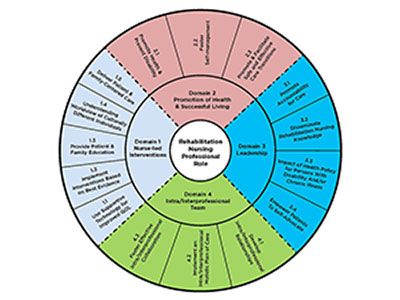Professional Rehabilitation Nursing Competency Model
The rehabilitation nursing specialty is practiced in multiple settings across the health care continuum. The Competency Model for Professional Rehabilitation Nursing, created to help guide your practice, embodies four domains that reflect all competencies necessary to promote rehabilitation nursing in the current healthcare environment.
click image below to enlarge
How the Competency Model Evolved
In 2014 a task force comprised of eight ARN members representing clinical practice and academia was charged with the development of a Competency Model for Professional Rehabilitation Nursing. The Model was comprised of four domains; Nurse-led Interventions, Promotion of Successful Living, Leadership, and Interprofessional Care, and the competencies for each domain at three levels of proficiency (beginner, intermediate, advanced) that integrated rehabilitation nursing knowledge, skills, and core values and beliefs into professional nursing practice. In 2020 a task force of ARN members, again representing different settings (clinical practice and academia) as well as different geographical areas reviewed and revised the model to reflect current rehabilitation nursing practice. The major model revisions include the addition of a competency to Domain one that focuses on the understanding of the worldview of individuals who are culturally different reflecting rehabilitation nursing’s multicultural approach and global reach. ARN, through its mission and strategic plan, purport that rehabilitation nursing care be inclusive, non-biased, and culturally sensitive. The definition of family throughout the model was modified to include any person or persons who provide support and care to the patient (client). Rehabilitation nurses are strong advocates for the patient-family and acknowledge social conditions that may influence the patient’s ability to access care and ensure that optimum care in the right setting is received. Another revision was the addition of the word intraprofessional to the Domain four title which reflects the nursing peer collaboration and feedback process integral to professional nursing practice in the various settings. All of these aforementioned values and concepts are integrated into the context of care throughout the revised ARN Model and its visual depiction of colorful concentric circles that highlight the domains and associated competencies. Application of each domain was highlighted by the task force in clinical exemplars which are accessible via the following links.
Implications for Model utilization include integration into the ARN educational materials such as the Core Curriculum, webinars, and other educational materials. Members have provided several salient examples of model integration into their organizations including staff orientation (onboarding) activities as well as annual education/skills day. It also can be used to explicate the rehabilitation nurse role on the intra/interprofessional team while fostering collaboration and consultation with other healthcare professions in the development and implementation of a holistic plan of care for the patient-family. Role descriptions, including clinical ladder programs based on the proficiency levels, can also be grounded in the ARN Competency Model of Professional Nursing. Rehabilitation nurses in academic and researcher/nurse scientist roles may also use the Model in their respective settings. A nurse researcher may use the Model to organize and frame a research study, such as examining the effectiveness of a nursing intervention The Model and its components are congruent with the current competencies for professional nursing education which guides the content throughout nursing curricula. ARN promotes and supports research and quality improvement projects that impact rehabilitation nursing practice in all settings.
Our hope is that the members will use the Model in their practice and provide ARN with any feedback about the Model utilization in their organizations. The Model has been widely touted by other professional nursing organizations, such as ANA, for its unique contribution to professional nursing practice. As a result, in 2019 the Association of Rehabilitation Nurses was asked to send representatives to Geneva to be part of an international technical working group sponsored by the World Health Organization (WHO) to create and disseminate a rehabilitation competency framework (RCF); and have continued their involvement in the development of rehabilitation interventions for various conditions. The WHO RCF can be adopted and adapted by countries in the process of developing rehabilitation education and systems of rehabilitation care for persons across the globe with disability and/or chronic conditions
Resources to Implement and Adopt the Model
ARN is pleased to make the following resources available to help facilitate the adoption and integration of the competency model and rehabilitation nursing concepts into school nursing programs in institutes of higher education such as accredited universities and colleges.
- ARN Updated Competency Model for Professional Rehabilitation Nursing: Practice Applications (PDF).The aim of this study was to describe a task force’s review procedures and share the updated model.
- Competency Model Overview Presentation (PPT). An overview of the Competency Model, as presented by Task Force Chair Dr. Stephanie Vaughn, PhD RN CRRN FAHA.
- Inside Looking Out: Updated Competency Model for Professional Rehabilitation Nursing Practice (PDF) This companion, but stand-alone, article to a 2022 publication further explicates and informs the updated Competency Model from inside looking out toward an increasing application for evidence-based practice (EBP).
- Care Transitions – Levels of Care (PDF). Rehabilitation nursing and the competencies defined in the model are applicable across all care settings. This PDF resource concisely and clearly illustrates the various levels of facility-based and home-based care and the characteristics of each.
- Competency-Specific Behavioral Scenarios (PPT). Designed to illustrate the competencies “in action,” each behavioral scenario explores the impact of new nurses exhibiting – and not exhibiting – beginner level proficiency in a competency.
- Behavioral Scenario for 1.1 - Use Supportive Technology for Improving Quality of Life for Persons with Disability (PPT).
- Behavioral Scenario for 1.2 - Implement Nursing and Interprofessional Interventions Based on Best Evidence to Manage the Patient’s Disability and/or Chronic Illness (PPT).
- Behavioral Scenario for 1.3 - Provide Patient and Caregiver Education in Relation to Disability, Chronic Illness, and Health Management (DCIHM) (PPT).
- Behavioral Scenario for 1.4 - Understand the Worldview of Individuals who are Culturally Different.
- Behavioral Scenario for 1.5 - Deliver Patient - and Family-Centered Care (PPT).
- Behavioral Scenario for 2.1 - Promote Health & Prevent Disability (PPT).
- Behavioral Scenario for 2.2 - Foster Self-Management (PPT).
- Behavioral Scenario for 2.3 - Promote and Facilitate Safe and Effective Care Transitions (PPT).
- Behavioral Scenario for 3.1 - Promote Accountability for Care (PPT).
- Behavioral Scenario for 3.2 - Disseminate Rehabilitation Nursing Knowledge (PPT).
- Behavioral Scenario for 3.3 - Impact Health Policy for Persons with Disability and/or Chronic Illness (PPT).
- Behavioral Scenario for 3.4 - Empower Patients to Self-Advocate (PPT).
- Behavioral Scenario for 4.1 - Developing Intra/Interprofessional Relationships (PPT).
- Behavioral Scenario for 4.2 - Implement an Intra/Interprofessional Holistic Plan of Care (PPT).
- Behavioral Scenario for 4.3 - Foster Effective Intra/Interprofessional Collaboration (PPT).


